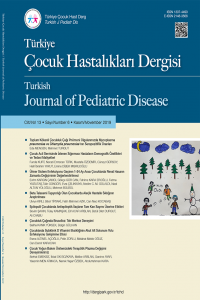Üriner Sistem Enfeksiyonu Geçiren 1-24 Ay Arası Çocuklarda Renal Hasarın Zamanla Değişiminin Değerlendirilmesi
Abstract
Amaç: Çocuklarda üriner sistem enfeksiyonu böbrek hasarı ile ilişkili olabilir. Literatürde, ateşli üriner sistem enfeksiyonundan 4-6 ay sonra çekilen renal sintigrafide yüksek sıklıkla lezyonlar olabileceğini bildiren yayınlar vardır. Bununla birlikte, bu lezyonların zaman içinde değişimi hakkındaki veriler son derece sınırlıdır. Çalışmada, üriner sistem enfeksiyonu geçiren küçük çocuklarda böbrek hasarının zaman içindeki değişimi ve böbrek hasarının ilerlemesiyle ilişkili faktörleri analiz etmeyi amaçladık.
Gereç ve Yöntemler: Bu çalışmada, yaşı 1-24 ay arasında olup ilk ateşli üriner sistem enfeksiyonu tanısından en az 90 gün sonra çekilen Teknesyum-99m dimerkaptosüksinik asit sintigrafisinde hasar tespit edilmiş ve 2 yıl sonra kontrol sintigrafisi yapılmış olan 143 hasta retrospektif olarak değerlendirildi.
Bulgular: DMSA sintigrafisinde renal hasar tespit edilen 143 çocuktan 27’sinde (%18.8) bulgularda ilerleme, 38’sinde (%26.5) bulgularda gerileme izlenirken, 78 (%54.5) hastada değişiklik olmadı. Cinsiyet veya yaş açısından gruplar arasında fark yoktu. Renal hasarda ilerleme saptanan grupta, 21/27 (%77.8) çocukta evre IV-V vezikoüreteral reflü ve 22 (%81.5) çocukta tekrarlayan üriner sistem enfeksiyonu mevcuttu. Çok değişkenli regresyon analizinde tekrarlayan üriner sistem enfeksiyonunun, böbrek hasarının ilerlemesinde bağımsız bir risk faktörü olduğu ortaya konmuştur. Renal hasarda gerileme olan grupta ise sadece 3/38 (%7.9) hastada evre IV-V vezikoüreteral reflü ve 4 (%10.5) hastada tekrarlayan üriner sistem enfeksiyonu vardı.
Sonuç: Üriner sistem enfeksiyonu geçiren küçük çocukların çoğunda renal hasar gelişmemekle birlikte renal hasar olması durumunda, bunların çoğunda zaman içinde değişiklik olmamakta ya da regresyon olmaktadır. Öte yandan, üriner sistem enfeksiyonu sonrası böbrek hasarı saptanan çocukların dörtte biri kadarı, renal fonksiyonlarda bozulma açısından risk altındadır. Renal hasarda ilerleme için tekrarlayan üriner sistem enfeksiyonu bağımsız bir risk faktörüdür. Bu çocuklarda altta yatan yüksek dereceli vezikoüreteral reflü saptanma olasılığı oldukça yüksektir. Renal hasar derecesinin değerlendirilmesi açısından bu çocukların uzun dönem izlemleri önemlidir.
References
- 1. Freedman AL. Urologic diseases in North America project: Trends in resource utilization for urinary tract infections in children. J Urol 2005;173: 949–54.
- 2. Barry BP, Hall N, Cornford E et al. Improved ultrasound detection of renal scarring in children following urinary tract infection. Clin Radiol 1998;53:747–51.
- 3. Geback C, Hansson S, Martinell J, Sandberg T, Sixt R, Jodal U. Renal function in adult women with urinary tract infection in childhood. Pediatr Nephrol 2015;30:1493–99.
- 4. Montini G, Tullus K, Hewitt I: Febrile urinary tract infections in children. N Engl J Med 2011;365:239–50.
- 5. Shaikh N, Ewing AL, Bhatnagar S, Hoberman A: Risk of renal scarring in children with a first urinary tract infection: A systematic review. Pediatrics 2010;126:1084–91.
- 6. Zaffanello M, Franchini M, Brugnara M, Fanos V. Evaluating kidney damage from vesico-ureteral reflux in children. Saudi J Kidney Dis Transpl 2009;20:57-68.
- 7. Penido Silva JM, Oliveria EA, Diniz JS, Bouzada MC, Vergara RM, Souza BC. Clinical course of prenatally detected primary vesicoureteral reflux. Pediatr Nephrol 2006;21:86-91.
- 8. Wennerstrom M, Hansson S, Jodal U, Stokland E. Primary and acquired renal scarring in boys and girls with urinary tract infection. J Pediatr 2000;136:30–4.
- 9. Wallin L, Helin I, Bajc M. Follow-up of acute pyelonephritis in children by Tc-99m DMSA scintigraphy: Quantitative and qualitative assessment. Clin Nucl Med 2001;26:423-32.
- 10. Swerkersson S, Jodal U, Sixt R, Stokland EPark YS. Renal scar formation after urinary tract infection in children. Korean J Pediatr 2012;55:367-70.
- 11. Hansson S. Urınary tract infection in small children: The evolution of renal damage over time. Pediatr Nephrol 2017;32:1907-13.
Details
| Primary Language | Turkish |
|---|---|
| Subjects | Internal Diseases |
| Journal Section | ORIGINAL ARTICLES |
| Authors | |
| Publication Date | December 23, 2019 |
| Submission Date | April 25, 2018 |
| Published in Issue | Year 2019 Volume: 13 Issue: 6 |
Cite
The publication language of Turkish Journal of Pediatric Disease is English.
Manuscripts submitted to the Turkish Journal of Pediatric Disease will go through a double-blind peer-review process. Each submission will be reviewed by at least two external, independent peer reviewers who are experts in the field, in order to ensure an unbiased evaluation process. The editorial board will invite an external and independent editor to manage the evaluation processes of manuscripts submitted by editors or by the editorial board members of the journal. The Editor in Chief is the final authority in the decision-making process for all submissions. Articles accepted for publication in the Turkish Journal of Pediatrics are put in the order of publication taking into account the acceptance dates. If the articles sent to the reviewers for evaluation are assessed as a senior for publication by the reviewers, the section editor and the editor considering all aspects (originality, high scientific quality and citation potential), it receives publication priority in addition to the articles assigned for the next issue.
The aim of the Turkish Journal of Pediatrics is to publish high-quality original research articles that will contribute to the international literature in the field of general pediatric health and diseases and its sub-branches. It also publishes editorial opinions, letters to the editor, reviews, case reports, book reviews, comments on previously published articles, meeting and conference proceedings, announcements, and biography. In addition to the field of child health and diseases, the journal also includes articles prepared in fields such as surgery, dentistry, public health, nutrition and dietetics, social services, human genetics, basic sciences, psychology, psychiatry, educational sciences, sociology and nursing, provided that they are related to this field. can be published.

